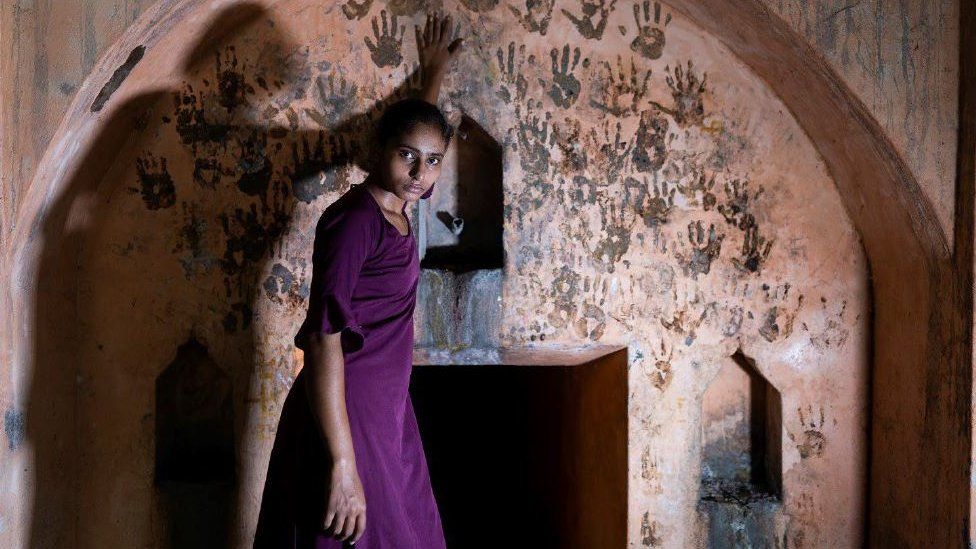Photojournalist Ruhani Kaur traces the story of three child brides from the northern Indian state of Haryana who dream of studying and working against all odds.
Priyanka, Meenakshi and Shiwani grew up in Damdama, an urban village that is home to Gujjars, an influential agricultural community. Their village is less than half an hour from Gurgaon, an upscale suburb of India’s capital, Delhi.
The girls, around 16 years old, have been friends since childhood. They are also child brides – one got married when she was just 10.
It is illegal for girls under the age of 18 to marry in India. But the practice still continues in many parts of the country due to patriarchy and poverty.
India is home to the largest number of child brides in the world, accounting for a third of the global total, according to the United Nations Children’s Fund, Unicef. The charity estimates that at least 1.5 million girls under 18 get married here each year.
Last year, the government introduced a bill in parliament to increase the minimum age of marriage to 21, but it hasn’t become a law yet.
The three friends desperately want to forge independent lives, but know there are big challenges ahead.
‘Don’t shackle me with marriage’
Priyanka was 10 when her family got her married. Seven years on, she is in Class 11, and still lives in her parents’ house.
But she has been told that she will have to go to live with her husband – who is studying for exams to join the police force – as soon as he gets a job.
She is scared, and pours her worries into her diary.
“Don’t shackle me with marriage, I’m too young… I don’t want to go to my mother-in-law, leaving my doll behind,” she writes.
Priyanka says she isn’t a very good student, but likes helping out at her brother’s beauty parlour – she hopes this can help her stay at home longer.
Her cousin – who is married to Priyanka’s husband’s brother – also learnt some parlour work but couldn’t continue because she too was married off. Priyanka yearns for a different life.
‘We shouldn’t get married until our dreams come true’
Last year, when Meenakshi entered Class 11, she became the first girl in her school to enrol in the science stream. Her happiness knew no bounds, she said then.

By that point, the coronavirus pandemic had changed lives. Millions lost their jobs during intermittent lockdowns, with many having to return to their hometowns and villages.
It was also a time when many parents of young girls, anxious about their future prospects, arranged their marriages.
A number of Meenakshi’s classmates got married during this period, but she hoped to hold on. “I don’t know about the right age [to get married] but until our dreams come true, we shouldn’t get married!” she would say, defiantly.
But on 5 February this year, she became part of that statistic.
The henna is still visible on Meenakshi’s hands as she reaches for her mobile phone, which is buzzing with messages from her 16-year-old husband. Her red bangles jingle as she types a reply.
Her husband is also studying, so Meenakshi’s parents have told her she can stay on in school for now. She hopes her parents and in-laws will let her study for as long as she wants to.
Dreams of working in a bank
There is visible excitement on Shiwani’s face when she speaks about studying – she loves going to school and dreams of becoming a banker.

But when her mother takes out her wedding album from the cupboard, Shiwani is jolted back to reality. She knows that her future may not be in her control after she finishes Class 12.
Shiwani and her elder sister Ashu got married on the same day – their uncle fixed their weddings along with that of his own daughter after the girls’ father fell ill.
“Nothing’s changed. I was married off at 15, and so was my daughter,” Shiwani’s mother says.
Their father had promised to let them finish Class 12, so both sisters clung fiercely to hope.

Ashu went to her husband’s house before her exam results were out. She wanted to study more, maybe even pursue law, and hoped her in-laws would agree.
But within a few months, she got pregnant. She gave birth earlier this year.

As life goes on in the village, on a bright autumn day, Priyanka, Shiwani and Meenakshi meet their friend Monu, who is free of any immediate pressure to marry.
They shriek in excitement as they ride a creaking Ferris wheel.
As they start spinning faster and faster, the girls forget their worries for a glorious moment.
This work was supported by National Geographic Society’s Emergency Fund for Journalists
All photos subject to copyright.

You might also be interested in:
This video can not be played
To play this video you need to enable JavaScript in your browser.





























